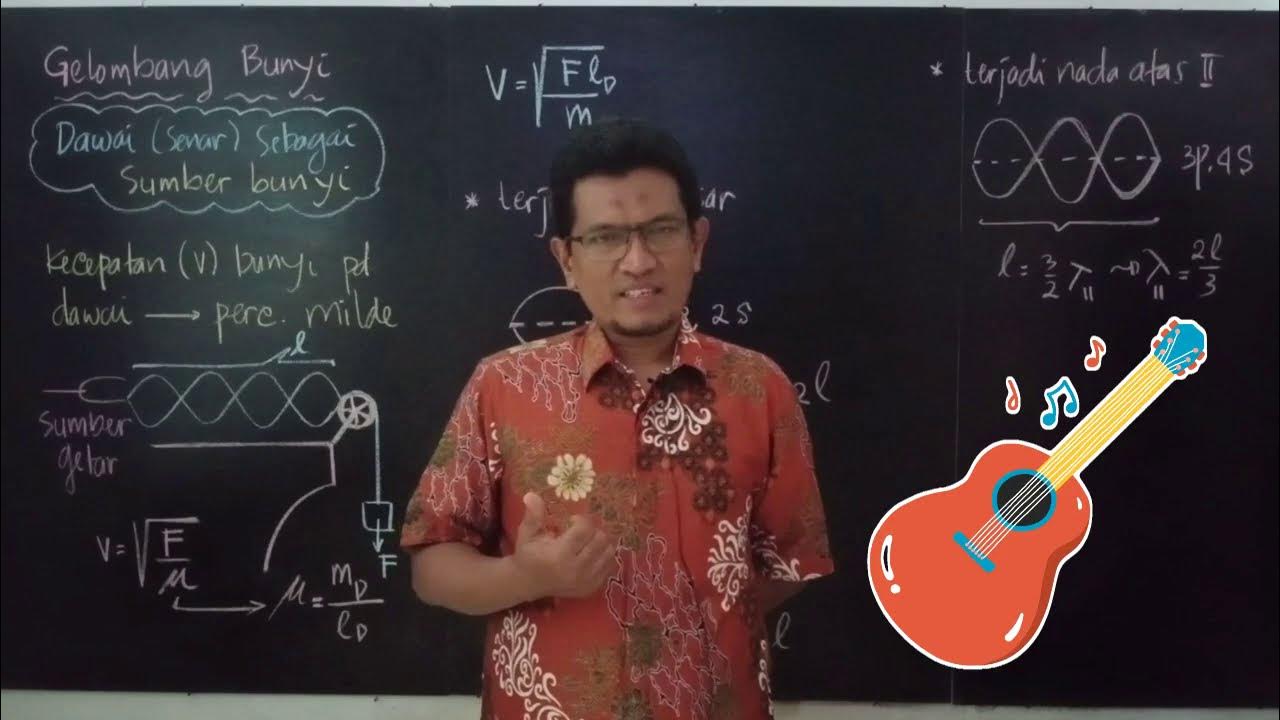Gelombang Bunyi Pada Dawai (Senar) | Materi Fisika Gelombang Bunyi Kelas 11 SMA
Summary
TLDRIn this video, the concept of sound waves and harmonic frequencies is explored using examples of musical instruments like guitars and violins. The script explains how vibrations on a string, known as 'dawai' in physics, produce sound by forming stationary waves with nodes and antinodes. The video discusses the different harmonic frequencies, such as the fundamental frequency (first harmonic) and higher harmonics, with explanations of how these frequencies relate to the string's length and tension. Mathematical formulas are presented to calculate the frequencies, offering viewers a deeper understanding of wave behavior in musical strings.
Takeaways
- 😀 Sound waves are longitudinal waves that travel in the direction of vibration, and they are generated by a sound source.
- 😀 A string (dawai) is an example of a medium used in sound production, with applications in instruments like guitars and violins.
- 😀 The wave on a string can be either transverse or longitudinal depending on the type of vibration.
- 😀 When a string is plucked, a transverse wave is created, and it reflects at both ends, forming standing waves.
- 😀 Standing waves on a string occur at specific frequencies and form harmonic patterns with different frequencies.
- 😀 The fundamental frequency (first harmonic) is formed when the string vibrates with both ends fixed, creating two nodes and one antinode.
- 😀 The formula for the fundamental frequency is f0 = v / (2l), where v is wave speed and l is the length of the string.
- 😀 The second harmonic (first overtone) occurs when the string is plucked at 1/4 of its length, forming three nodes and two antinodes.
- 😀 The frequency of the second harmonic is given by f1 = v / l, where l is the length of the string.
- 😀 Higher harmonics are formed by plucking the string at fractional lengths (e.g., 1/6, 1/8), each producing more complex standing wave patterns.
- 😀 The fourth harmonic (third overtone) occurs when the string is plucked at 1/8 of its length, creating a wave pattern with four nodes and three antinodes.
Q & A
What is the relationship between sound waves and vibrating strings?
-Sound waves are longitudinal waves that propagate in the direction of vibration. Vibrating strings, like those on musical instruments, generate sound waves when they vibrate, which can be studied in terms of frequency and harmonic patterns.
What is a longitudinal wave?
-A longitudinal wave is a wave in which the particles of the medium move parallel to the direction of the wave. In the case of sound, this means that the compression and rarefaction of air particles occur in the direction the sound is traveling.
What is a standing wave, and how is it formed on a string?
-A standing wave is formed when waves traveling in opposite directions interfere with each other, creating fixed points known as nodes and antinodes. In the case of a vibrating string, standing waves occur when waves reflect from the fixed ends and interfere with incoming waves.
What is the significance of the nodes and antinodes in the context of vibrating strings?
-Nodes are points on the string where there is no displacement (the wave does not move), while antinodes are points where the displacement is maximum (the wave moves the most). The arrangement of nodes and antinodes determines the frequency of the vibration.
What is the formula for calculating the fundamental frequency of a vibrating string?
-The formula for the fundamental frequency (f₀) is f₀ = v / (2L), where v is the wave speed and L is the length of the string.
How is the first harmonic (fundamental frequency) formed on a string?
-The first harmonic, or fundamental frequency, occurs when the string vibrates such that there are two fixed points (nodes) at the ends and one vibrating point (antinode) at the center of the string.
What happens when a string is plucked at one-quarter of its length?
-When a string is plucked at one-quarter of its length, it produces the second harmonic, which forms three nodes and two antinodes, resulting in a vibration pattern with one complete wave on the string.
What is the relationship between string length and frequency for higher harmonics?
-For higher harmonics, as the string length decreases, the frequency increases. This is because higher harmonics correspond to shorter wavelengths, which are inversely related to the string length.
What is the formula for calculating the frequency of the second harmonic?
-The frequency of the second harmonic (f₁) is given by the formula f₁ = v / L, where v is the wave speed and L is the length of the string.
How do the number of nodes and antinodes change as you move to higher harmonics?
-As you move to higher harmonics, the number of nodes increases, and the number of antinodes increases as well. For the first harmonic, there is 1 antinode and 2 nodes. For the second harmonic, there are 2 antinodes and 3 nodes, and so on.
Outlines

Cette section est réservée aux utilisateurs payants. Améliorez votre compte pour accéder à cette section.
Améliorer maintenantMindmap

Cette section est réservée aux utilisateurs payants. Améliorez votre compte pour accéder à cette section.
Améliorer maintenantKeywords

Cette section est réservée aux utilisateurs payants. Améliorez votre compte pour accéder à cette section.
Améliorer maintenantHighlights

Cette section est réservée aux utilisateurs payants. Améliorez votre compte pour accéder à cette section.
Améliorer maintenantTranscripts

Cette section est réservée aux utilisateurs payants. Améliorez votre compte pour accéder à cette section.
Améliorer maintenantVoir Plus de Vidéos Connexes

Standing Waves

Gelombang Bunyi • Part 3: Sumber Bunyi (Dawai, Pipa Organa Terbuka dan Tertutup)

How Sound Works - The Physics of Sound Waves

DAWAI (SENAR) SEBAGAI SUMBER BUNYI | Gelombang Bunyi #1 - Fisika Kelas 11

Gelombang Bunyi 1 - Sumber Bunyi (Dawai & Pipa Organa)

The most mind-blowing concept in music (Harmonic Series)
5.0 / 5 (0 votes)
